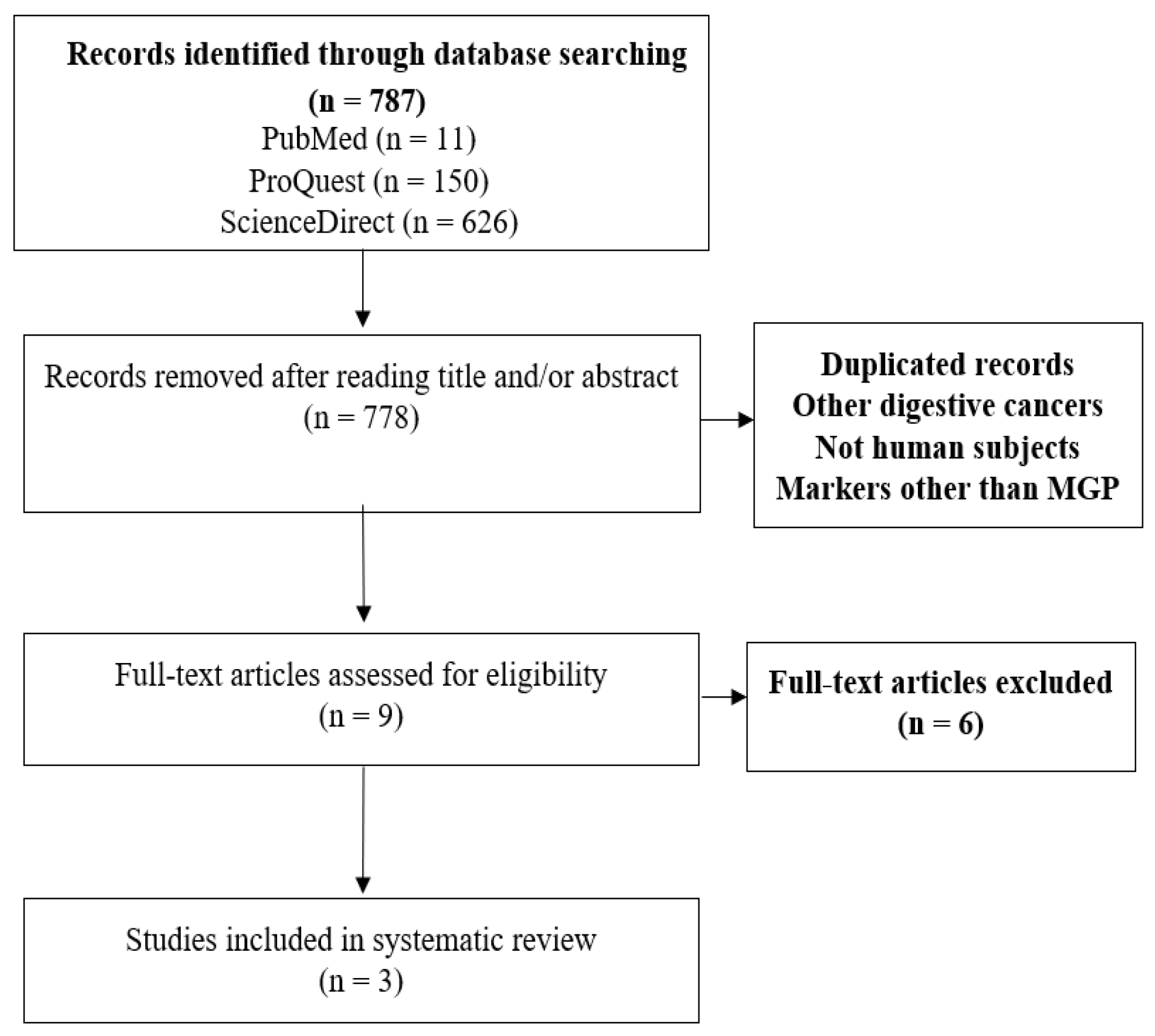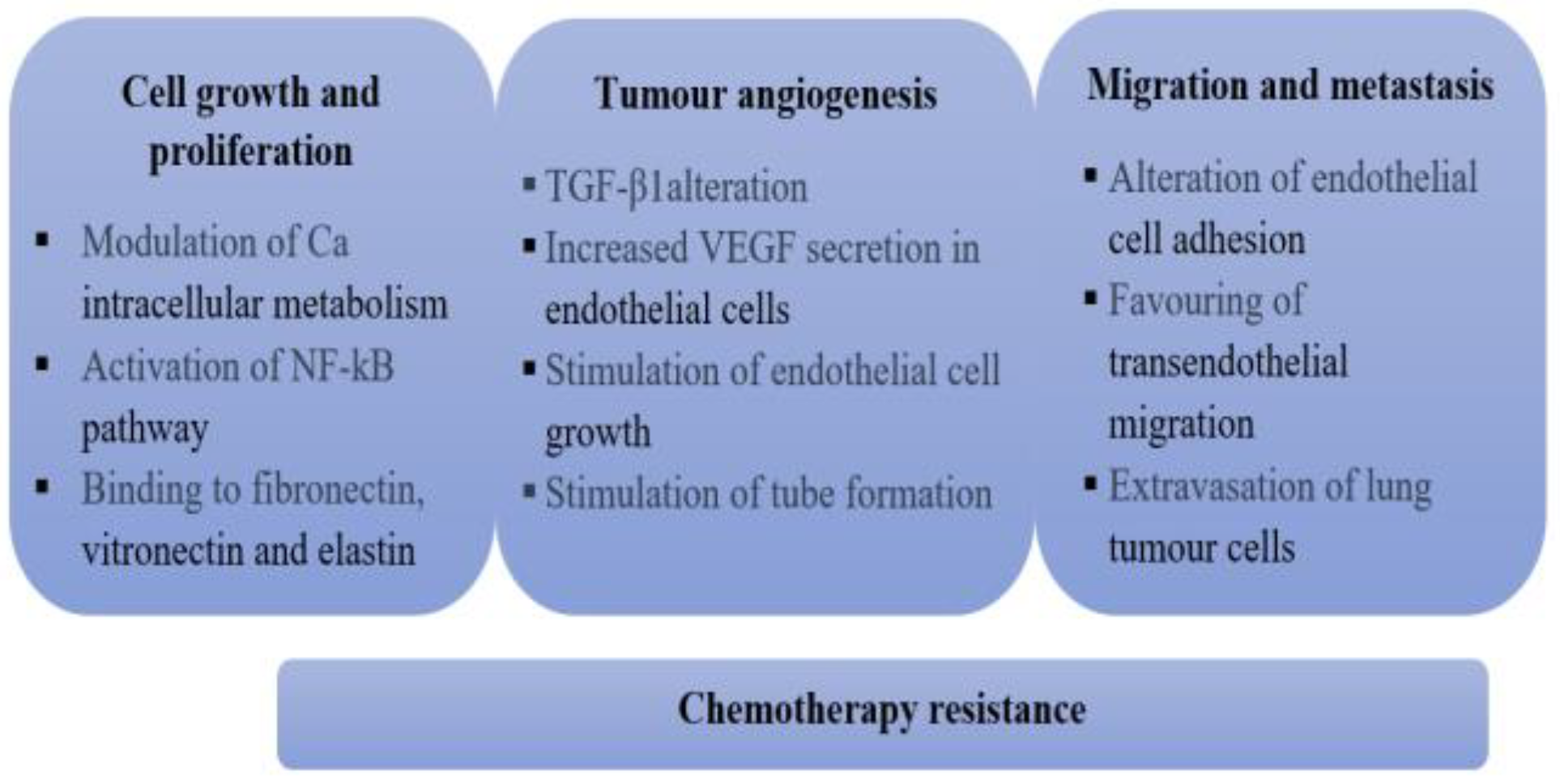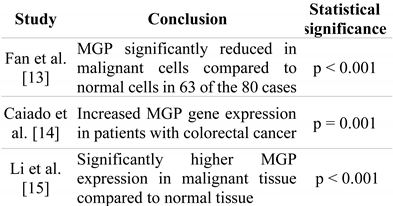Matrix Gla Protein—A New Marker for Colorectal Cancer Detection? A Systematic Review
Abstract
:Introduction
Materials and Methods
Database search strategy
Inclusion and exclusion criteria
Data collection and analysis
Results
Article search
Characterization of studies
Conclusions of studies
Discussions
Conclusions
Compliance with ethical standards
Conflict of interest disclosure
References
- Rawla, P.; Sunkara, T.; Barsouk, A. Epidemiology of colorectal cancer: Incidence, mortality, survival, and risk factors. Przegla̜d Gastroenterol. 2019, 14, 89–103. [Google Scholar] [CrossRef] [PubMed]
- Arnold, M.; Sierra, M.S.; Laversanne, M.; Soerjomataram, I.; Jemal, A.; Bray, F. Global patterns and trends in colorectal cancer incidence and mortality. Gut 2017, 66, 683–691. [Google Scholar] [CrossRef]
- Cancela, M.L.; Laizé, V.; Conceição, N. Matrix Gla protein and osteocalcin: From gene duplication to neofunctionalization. Arch. Biochem. Biophys. 2014, 561, 56–63. [Google Scholar] [CrossRef] [PubMed]
- Gheorghe, S.R.; Crăciun, A.M. Matrix Gla protein in tumoral pathology. Med. Pharm. Rep. 2016, 89, 319–321. [Google Scholar] [CrossRef] [PubMed]
- Price, P.A.; Urist, M.R.; Otawara, Y. Matrix Gla protein, a new γ-carboxyglutamic acid-containing protein which is associated with the organic matrix of bone. Biochem. Biophys. Res. Commun. 1983, 117, 765–771. [Google Scholar] [CrossRef]
- Wei, F.-F.; Trenson, S.; Verhamme, P.; Vermeer, C.; Staessen, J.A. Vitamin K–Dependent Matrix Gla Protein as Multifaceted Protector of Vascular and Tissue Integrity. Hypertension 2019, 73, 1160–1169. [Google Scholar] [CrossRef]
- Theuwissen, E.; Smit, E.; Vermeer, C. The Role of Vitamin K in Soft-Tissue Calcification. Adv. Nutr. Int. Rev. J. 2012, 3, 166–173. [Google Scholar] [CrossRef]
- Kuzontkoski, P.M.; Mulligan-Kehoe, M.J.; Harris, B.T.; A Israel, M. Inhibitor of DNA binding-4 promotes angiogenesis and growth of glioblastoma multiforme by elevating matrix GLA levels. Oncogene 2010, 29, 3793–3802. [Google Scholar] [CrossRef]
- Sharma, B.; Albig, A.R. Matrix Gla protein reinforces angiogenic resolution. Microvasc. Res. 2012, 85, 24–33. [Google Scholar] [CrossRef]
- Chen, L.; Obryan, J.; Smith, H.; Liu, E. Overexpression of matrix gla protein messenger-rna in malignant human breast cells - isolation by differential cdna hybridization. Oncogene 1990, 5, 1391–1395. [Google Scholar]
- Levedakou, E.N.; Strohmeyer, T.G.; Effert, P.J.; Liu, E.T. Expression of the matrix Gla protein in urogenital malignancies. Int. J. Cancer 1992, 52, 534–537. [Google Scholar] [CrossRef] [PubMed]
- Moher, D.; Liberati, A.; Tetzlaff, J.; Altman, D.G.; The PRISMA Group. Preferred Reporting Items for Systematic Reviews and Meta-Analyses: The PRISMA Statement. J. Clin. Epidemiol. 2009, 62, 1006–1012. [Google Scholar] [CrossRef] [PubMed]
- Fan, C.-W.; Sheu, D.-L.; Fan, H.-A.; Hsu, K.-C.; Chang, C.A.; Chan, E.-C. Down-regulation of matrix Gla protein messenger RNA in human colorectal adenocarcinomas. Cancer Lett. 2001, 165, 63–69. [Google Scholar] [CrossRef] [PubMed]
- Caiado, H.; Conceição, N.; Tiago, D.; Marreiros, A.; Vicente, S.; Enriquez, J.L.; Vaz, A.M.; Antunes, A.; Guerreiro, H.; Caldeira, P.; et al. Evaluation of MGP gene expression in colorectal cancer. Gene 2020, 723, 144120. [Google Scholar] [CrossRef]
- Li, X.; Wei, R.; Wang, M.; Ma, L.; Zhang, Z.; Chen, L.; Guo, Q.; Guo, S.; Zhu, S.; Zhang, S.; et al. MGP Promotes Colon Cancer Proliferation by Activating the NF-κB Pathway through Upregulation of the Calcium Signaling Pathway. Mol. Ther. - Oncolytics 2020, 17, 371–383. [Google Scholar] [CrossRef]
- Tiago, D.M.; Conceição, N.; Caiado, H.; Laizé, V.; Cancela, M.L. Matrix Gla protein repression by miR-155 promotes oncogenic signals in breast cancer MCF-7 cells. FEBS Lett. 2016, 590, 1234–1241. [Google Scholar] [CrossRef]
- Wang, M.; Chen, L.; Chen, Y.; Wei, R.; Guo, Q.; Zhu, S.; Guo, S.; Zhu, S.; Zhang, S.; Min, L. Intracellular matrix Gla protein promotes tumor progression by activating JAK2/STAT5 signaling in gastric cancer. Mol. Oncol. 2020, 14, 1045–1058. [Google Scholar] [CrossRef]
- Mertsch, S.; Schurgers, L.J.; Weber, K.; Paulus, W.; Senner, V. Matrix gla protein (MGP): an overexpressed and migration-promoting mesenchymal component in glioblastoma. BMC Cancer 2009, 9, 302–302. [Google Scholar] [CrossRef]
- Fu, M.-H.; Wang, C.-Y.; Hsieh, Y.-T.; Fang, K.-M.; Tzeng, S.-F. Functional Role of Matrix gla Protein in Glioma Cell Migration. Mol. Neurobiol. 2017, 55, 4624–4636. [Google Scholar] [CrossRef]
- Boström, K.; Zebboudj, A.F.; Yao, Y.; Lin, T.S.; Torres, A. Matrix GLA Protein Stimulates VEGF Expression through Increased Transforming Growth Factor-β1 Activity in Endothelial Cells. J. Biol. Chem. 2004, 279, 52904–52913. [Google Scholar] [CrossRef]
- Zandueta, C.; Ormazábal, C.; Perurena, N.; Martínez-Canarias, S.; Zalacaín, M.; Julián, M.S.; Grigoriadis, A.E.; Valencia, K.; Campos-Laborie, F.J.; Rivas, J.D.L.; et al. Matrix-Gla protein promotes osteosarcoma lung metastasis and associates with poor prognosis. J. Pathol. 2016, 239, 438–449. [Google Scholar] [CrossRef] [PubMed]
- Nishimoto, S.K.; Nishimoto, M. Matrix Gla Protein Binds to Fibronectin and Enhances Cell Attachment and Spreading on Fibronectin. Int. J. Cell Biol. 2014, 2014, 1–13. [Google Scholar] [CrossRef] [PubMed]
- Tudosie, M.; Pauna, A.; Stefani, C.; Staicu, I. Diet and Food chemicals increasing the risk of colorectal cancer – literature review. J. Mind Med Sci. 2022, 9, 118–124. [Google Scholar] [CrossRef]
- Nishimoto, S.; Nishimoto, M. Matrix Gla protein C-terminal region binds to vitronectin. Co-localization suggests binding occurs during tissue development. Matrix Biol. 2005, 24, 353–361. [Google Scholar] [CrossRef]
- Güngören, F.; Erol, C.; Bilici, A.; Dayangaç, M.; Şeker, M.; Ölmez, Ö.; Yaprak, O.; Yıldız, Ö.; Öncel, M. The comparison of local tumor control after microwave ablation, surgical resection and combined treatment for colorectal liver metastases. J. Mind Med Sci. 2022, 9, 125–132. [Google Scholar] [CrossRef]
- Sterzyńska, K.; Klejewski, A.; Wojtowicz, K.; Świerczewska, M.; Andrzejewska, M.; Rusek, D.; Sobkowski, M.; Kędzia, W.; Brązert, J.; Nowicki, M.; et al. The Role of Matrix Gla Protein (MGP) Expression in Paclitaxel and Topotecan Resistant Ovarian Cancer Cell Lines. Int. J. Mol. Sci. 2018, 19, 2901. [Google Scholar] [CrossRef] [PubMed]
- Yao, J.; Guihard, P.J.; Blazquez-Medela, A.M.; Guo, Y.; Liu, T.; Boström, K.I.; Yao, Y. Matrix Gla protein regulates differentiation of endothelial cells derived from mouse embryonic stem cells. Angiogenesis 2015, 19, 1–7. [Google Scholar] [CrossRef]
- Januchowski, R.; Zawierucha, P.; Ruciński, M.; Nowicki, M.; Zabel, M. Extracellular Matrix Proteins Expression Profiling in Chemoresistant Variants of the A2780 Ovarian Cancer Cell Line. BioMed Res. Int. 2014, 2014, 1–9. [Google Scholar] [CrossRef]





© 2023 by the author. 2023 Mirela-Georgiana Perné, Lorena Ciumărnean, Olga-Hilda Orășan, Vasile Negrean, Teodora-Gabriela Alexescu, Mircea Vasile Milaciu, Ioana Roșca, Răzvan Dan Togănel, Gabriel Emil Petre, Lucia Procopcoiuc, Cristina Drugan, Alexandra Crăciun.
Share and Cite
Perné, M.-G.; Ciumărnean, L.; Orășan, O.-H.; Negrean, V.; Alexescu, T.-G.; Milaciu, M.V.; Roșca, I.; Togănel, R.D.; Petre, G.E.; Procopcoiuc, L.; et al. Matrix Gla Protein—A New Marker for Colorectal Cancer Detection? A Systematic Review. J. Mind Med. Sci. 2023, 10, 66-71. https://doi.org/10.22543/2392-7674.1373
Perné M-G, Ciumărnean L, Orășan O-H, Negrean V, Alexescu T-G, Milaciu MV, Roșca I, Togănel RD, Petre GE, Procopcoiuc L, et al. Matrix Gla Protein—A New Marker for Colorectal Cancer Detection? A Systematic Review. Journal of Mind and Medical Sciences. 2023; 10(1):66-71. https://doi.org/10.22543/2392-7674.1373
Chicago/Turabian StylePerné, Mirela-Georgiana, Lorena Ciumărnean, Olga-Hilda Orășan, Vasile Negrean, Teodora-Gabriela Alexescu, Mircea Vasile Milaciu, Ioana Roșca, Răzvan Dan Togănel, Gabriel Emil Petre, Lucia Procopcoiuc, and et al. 2023. "Matrix Gla Protein—A New Marker for Colorectal Cancer Detection? A Systematic Review" Journal of Mind and Medical Sciences 10, no. 1: 66-71. https://doi.org/10.22543/2392-7674.1373
APA StylePerné, M.-G., Ciumărnean, L., Orășan, O.-H., Negrean, V., Alexescu, T.-G., Milaciu, M. V., Roșca, I., Togănel, R. D., Petre, G. E., Procopcoiuc, L., Drugan, C., & Crăciun, A. (2023). Matrix Gla Protein—A New Marker for Colorectal Cancer Detection? A Systematic Review. Journal of Mind and Medical Sciences, 10(1), 66-71. https://doi.org/10.22543/2392-7674.1373



